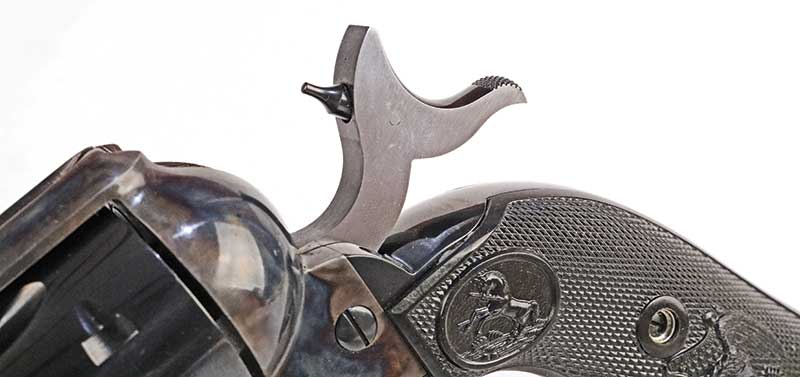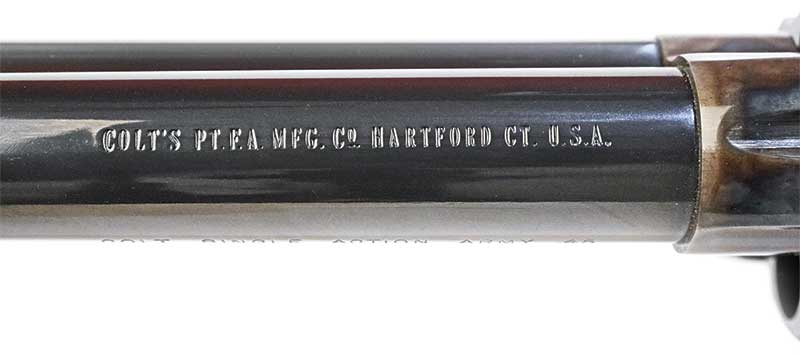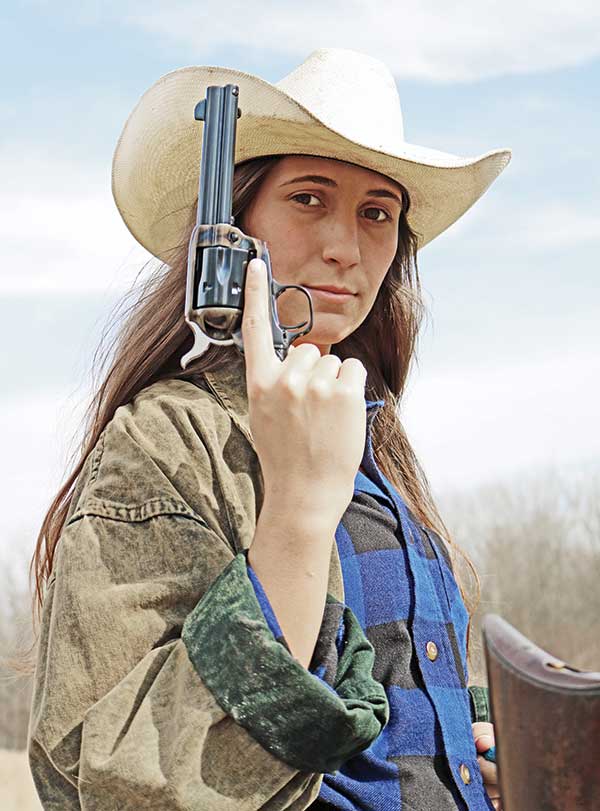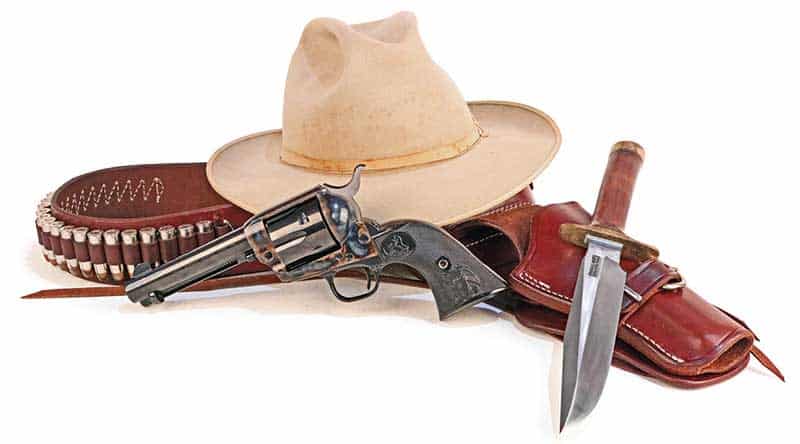Unicorn Hunting
One Man's Quest For A
Genuine Colt Peacemaker
There’s something just a wee bit mystical about the Colt Single Action Army. Nothing about the gun looks particularly ergonomic. The grip lacks finger grooves or palm swells. The hammer is enormous and perched atop the frame like some garish steel antler. The trigger is little more than a curved bit of heavy wire. However, mix all this stuff together and you have a battle-proven handgun riding in the hand like God put it there along with your fingers or your nose. The effect really is surreal.
Lots of folks make replicas of Colt’s classic Western sixgun these days. Italian ones represent a great value, while customized domestic versions with unique finishes or extensive engraving cost more than my car. My mission was to find a genuine Colt Single Action Army for my own collection. I wasn’t looking for something old and weathered with a story; I just wanted a factory-new Peacemaker. This quest took me to some interesting places. To fully appreciate the nature of this elusive handgun, we need to explore a spot of history.
In The Beginning …
Famed inventor and businessman Samuel Colt was born in Hartford, Connecticut, in 1814. At age 15 he staged a demonstration on a local waterway wherein he used a homemade galvanic cell to detonate an underwater mine. He missed his intended target yet left the crowd most thoroughly entertained. In 1830 he inadvertently set fire to his school and was subsequently sent away to learn the seaman’s trade.
During a voyage to Calcutta aboard the brig Corvo, Colt was inspired by the ship’s capstan with its ratchet and pawl mechanism. He subsequently crafted a wooden model of a revolving handgun based upon the device while aboard ship. Upon his return home Colt’s father agreed to fund the construction of a prototype handgun and rifle based upon his idea. The rifle performed well. The pistol exploded.
In 1835 Colt traveled to London and secured, with some difficulty, a patent for his revolving handgun. He followed this up with a similar patent back home. Colt never claimed to have invented the revolver. He simply made it reliable and practical. Colt’s true legend was not the gun: It was how it was made.
Colt’s goal all along was to mass-produce his pistols with reliably interchangeable parts. While this seems like background clutter in the Information Age, maintaining such mechanical tolerances was heady stuff indeed in the mid-19th century. This basic mechanical goal ultimately made Samuel Colt America’s first true industrial tycoon.
Colt’s pistols sputtered along, and he diversified into such stuff as underwater mines, telegraph cable and tinfoil. Numerous competing companies willfully infringed upon Colt’s revolver patent, and he vigorously pursued satisfaction in court. By 1857 his original patent had expired, and he strived to dominate the market by providing quality weapons at reasonable prices. He had a novel way of running his enterprise.
A Most Benevolent Taskmaster
Colt opened his first Connecticut factory in 1848. It was here Colt refined his industrial vision. To help control flooding he planted German osiers, a sort of willow tree, along a long dike on the property. Ever the businessman, Colt then raised a factory to produce wicker furniture made from these trees.
Along the way Colt established a standardized 10-hour workday with a mandatory one-hour lunch break. He built onsite tenement housing for his workers as well as extensive recreational facilities. While his treatment of his employees was massively more humane than was the standard of the day, he could still dismiss a worker for tardiness, poor performance or having the audacity to suggest improvements to his products. The last one would come back to bite him.
Rollin White was a contract employee turning barrels for Colt. In his free time White obtained a pair of scrapped Colt revolver cylinders and welded them together. He cut the ends off on his lathe and subsequently imagined the bored-through cylinder characterizing every modern revolver on the planet.
Rollin took his idea to Colt who told him to drop dead. White subsequently approached Smith & Wesson with his invention, and they gave him a much warmer reception. White got a royalty of 25 cents for every gun produced, and S&W got a monopoly on the breech-loading revolver. Sam Colt had just committed his most epic blunder.
The Next Generation
The American Civil War revitalized the munitions industry as only a massive nationwide conflict is able, and Colt profited from it. Sam happily sold revolvers to both the North and the South at one point or another. As late as 1861 he still had designs on building a factory to produce handguns in the South for the Confederacy. Throughout it all he was constrained to percussion-fired pistols because of Rollin White’s pesky patent.
Colt was commissioned a colonel in the Connecticut Militia May of 1861. His unit was titled the 1st Regiment Colts Revolving Rifles of Connecticut and was armed with — you guessed it — Colt Revolving rifles. The unit was subsequently disbanded, and Colt was discharged 31 days after his commissioning. He did, however, wield the title Colonel Sam Colt proudly from then on.
Colt died of complications secondary to gout in 1862. By the medical standards of the day this was likely a fairly horrific way to go. At the time of his death he was worth millions.
The Definitive Colt
The company Sam Colt founded was not idle after his death. Rollin White’s patent finally expired in 1869, and the company could at last get about the business of producing cartridge-fed revolvers unfettered. Colt engineers William Mason and Charles Brinckerhoff Richards crafted a thoroughly modern design for the U.S. government service revolver trials of 1872. Their pistol handily won the competition, and production began in 1873. The formal appellation was the “New Model Metallic Cartridge Revolving Pistol.” The military called it the Colt Single Action Army. Most normal folk just called the new gun the Peacemaker.
The gun was chambered for the .45 Colt centerfire cartridge and carried plenty of downrange horsepower. The Single Action Army served as the Army’s standard sidearm for nearly 20 years before being replaced by the double-action Colt Model 1892 in .38 Long Colt. Concerns over knockdown power saw the old Single Action Army pistols dusted off and used as late as the Spanish American War. George Patton employed an ivory-gripped SAA to dispatch a pair of Pancho Villa’s lieutenants. He subsequently carried this gun throughout World War II.
And Finally, The Quest …
At last, I set about landing one of these classic guns of my own. I bet you thought I had forgotten. These timeless iconic wheelguns still grace the Colt website today. They list six different variations in both .45 Colt and .357 Magnum. Barrel lengths come in 4.75″, 5.5″ and the period original 7.5″ versions. Case-hardened frames, 1873-standard rubber grips and gorgeous blue highlights define the genre. Each model sports a disheartening “Out of Stock” label where the “Take Me Home” button should be. Demand for Colt’s archetypal wheelgun has likely never been higher, but the company originally birthing the thing is not really in a position to take advantage of it.
Quality Italian clones can be had at really sweet prices. The guns on the Colt website are all monotonously listed at $1,799. The samples I found on Gunbroker.com were typically going for substantially more.
I poked around a bit trying to get the real skinny on contemporary production. Some guy on Reddit claims they are currently releasing about five guns per day through their standard harem of distributors. Maybe this dude knows what he’s talking about. Or perhaps he is just some kid in his parents’ basement with a healthy supply of hallucinogens and an internet connection.
You’ve likely got to know somebody to land one of those guns nowadays. Nepotism is always a bad thing unless it helps me. It’s how I got mine.
I have written for the gun press for a quarter century and as a result have made a few friends in interesting places. A dear friend who is well connected helped me out, though I did end up paying top dollar. Once the gun arrived it was everything I had imagined it might be.
The fit is literally flawless. Peering into the deep, wet-looking blue finish is like sneaking a glimpse through the pearly gates. The action cycles like greased glass, and the angry end of the cylinder is scarier than the shark in “Jaws.”
I never thought I’d be That Guy. I should shoot the gun, but I just can’t bring myself to do it. So why exactly did I lay down the better part of two grand and call in a serious solid to purchase a clunky .45-caliber wheelgun almost identical to dozens if not hundreds of others readily available on the open market? Because it’s got the cool little horse engraved into the side, of course.
For more info:
www.colt.com, Ph: (800) 962-2658
Subscribe To American Handgunner

Get More Revolver Content Every Week!
Sign up for the Wheelgun Wednesday newsletter here:












